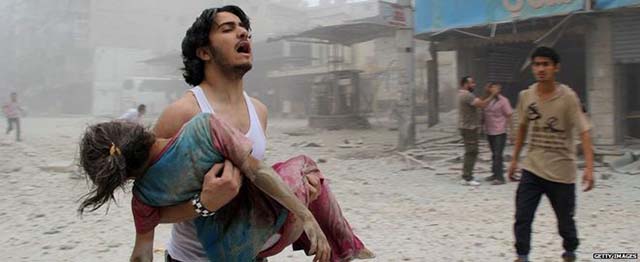Now after more than four years after it began, the full-blown civil war that developed in Syria has killed over 250,000 people, half of them civilians. In addition the UN estimates nearly 8 million Syrians have been displaced from their homes. When the additional 4 million Syrians who have fled into neighbouring countries are taken into account, it follows that a humanitarian disaster has overtaken more than half of the country’s pre-war population of 23 million. In addition to taking a very high toll on humanity the Syrian conflict has devastated every component from which a country stands on its own population, civil society, infrastructure, cultural heritage and economy. Prior to the conflict Syria was a middle-income country with an economy based on agriculture, industry, oil, trade and tourism with good health care and education. But now everything has changed after four years of civil war everything cease to exit. This calamity of war affects all aspects of people’s well-being since it was often accompanied by the loss of income and livelihoods with families struggling to meet their basic needs. Let’s see how this war has affected different sectors of the country.
Economy- The economic fabric has lost nearly 80% of its productive capacity since the beginning of the civil war. Even if the conflict ceased now and GDP grew at an average rate of five per cent each year, it is estimated that it would take the Syrian economy 30 years to return to the economic level of 2010. The Syrian economy has experienced massive de-industrialisation, dilapidation and degradation as a result of business closure and bankruptcy, capital flight, looting and destruction. Previously the eastern Mediterranean’s leading oil and natural gas producer, Syria has seen its production fall to a fraction of pre-conflict levels. Syria is no longer able to export oil, and as a result, government revenues from the energy sector have fallen significantly. Agricultural activities continue at a reduced level increasing the reliance on imported foodstuffs, particularly grain. Many businesses now rely on expensive foreign imports for their stock. The continuously depreciating currency has meant that US dollars are highly sought after, with some traders and businesses refusing to accept Syrian pounds. Because of all this worst impact on the economy 48.8 per cent of the workforce is unemployed. Also, more than half of the Syrian population are living in poverty, with some 4.4 million (or more than a fifth of the population) living in abject poverty.
Infrastructure- Has been damaged as a result of the conflict and direct targeting by armed groups, with widespread damage to electricity and water infrastructure, oil refineries, education facilities and agricultural infrastructure. Syrian children have already missed out on almost years of schooling. It is estimated by the World Health Organization that 37 percent of Syrian hospitals have been destroyed, and a further 20 percent severely damaged during the civil war. Civilians are forced to go to primitive field hospitals, often run in people’s homes and by local volunteers with only the most basic of medicines and training. Electricity and water service in much of the country is sporadic as a result of fighting between government, opposition forces and the Islamic State. Further, the exploration and development of the country’s oil and natural gas resources have been delayed indefinitely. Nevertheless, even if the fighting were to subside, it would take years for the Syrian domestic energy system to return to pre-conflict operating status. Syria’s domestic pipeline network used to be well-developed, now it has been severely damaged by fighting and sabotage since war broke out.
Cultural/Social Fabric- Numerous archaeological sites of great importance in Syria are being systematically targeted and destroyed by the Islamic State. Museums in Syria are also a cause for concern, and there have been many incidences of looting of valuable cultural property. A large number of museums have also had their infrastructure damaged as a result of being caught in the middle of armed conflict. Syrian cultural property has disappeared from the country to end up on the black market and/or in private collections. The ongoing uncontrolled violence has led to a broad disintegration of Syrian society and created different worlds. Things have changed and there are qualitative variables that left deep scars in the conscience of the people. Once a vibrant and peace loving society is now full of hatred and distrust people of different ethnic group now can’t expect to live besides each other.
It is evident, that Syria lost all its gains throughout decades, and that all development indicators are directed towards an abyss, and that not any realistic force can change this trend. Even in the case of a political and developmental miracle, the maximum that can be achieved is a return back to up to two decades or more in development indicators. But the spirit of past Syria no longer exists now. Only time will tell that who win’s or who lose this war but one thing is certain that Syria as a country has already lost the struggle of its survival. May be in the future the coming generations of Syria will know in the stories that once a country called Syria exited on the planet.

